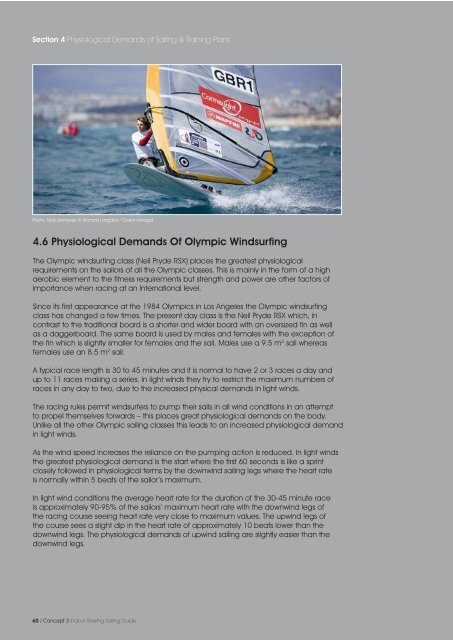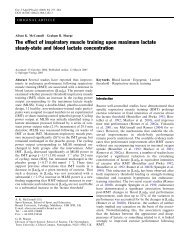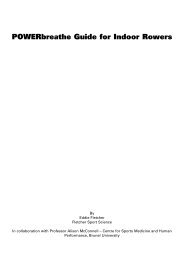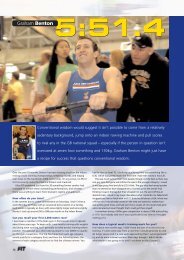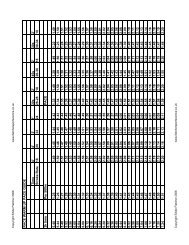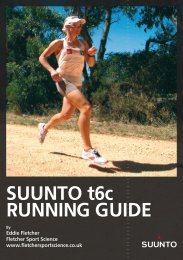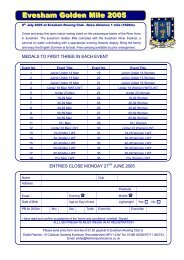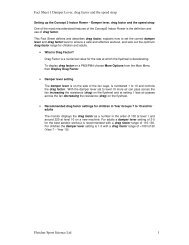Concept2-Sailing Rowing Guide.indd - Fletcher Sport Science
Concept2-Sailing Rowing Guide.indd - Fletcher Sport Science
Concept2-Sailing Rowing Guide.indd - Fletcher Sport Science
You also want an ePaper? Increase the reach of your titles
YUMPU automatically turns print PDFs into web optimized ePapers that Google loves.
Section 4 Physiological Demands of <strong>Sailing</strong> & Training Plans<br />
Photo: Nick Dempsey © Richard Langdon / Ocean Images<br />
4.6 Physiological Demands Of Olympic Windsurfing<br />
The Olympic windsurfing class (Neil Pryde RSX) places the greatest physiological<br />
requirements on the sailors of all the Olympic classes. This is mainly in the form of a high<br />
aerobic element to the fitness requirements but strength and power are other factors of<br />
importance when racing at an International level.<br />
Since its first appearance at the 1984 Olympics in Los Angeles the Olympic windsurfing<br />
class has changed a few times. The present day class is the Neil Pryde RSX which, in<br />
contrast to the traditional board is a shorter and wider board with an oversized fin as well<br />
as a daggerboard. The same board is used by males and females with the exception of<br />
the fin which is slightly smaller for females and the sail. Males use a 9.5 m 2 sail whereas<br />
females use an 8.5 m 2 sail.<br />
A typical race length is 30 to 45 minutes and it is normal to have 2 or 3 races a day and<br />
up to 11 races making a series. In light winds they try to restrict the maximum numbers of<br />
races in any day to two, due to the increased physical demands in light winds.<br />
The racing rules permit windsurfers to pump their sails in all wind conditions in an attempt<br />
to propel themselves forwards – this places great physiological demands on the body.<br />
Unlike all the other Olympic sailing classes this leads to an increased physiological demand<br />
in light winds.<br />
As the wind speed increases the reliance on the pumping action is reduced. In light winds<br />
the greatest physiological demand is the start where the first 60 seconds is like a sprint<br />
closely followed in physiological terms by the downwind sailing legs where the heart rate<br />
is normally within 5 beats of the sailor’s maximum.<br />
In light wind conditions the average heart rate for the duration of the 30-45 minute race<br />
is approximately 90-95% of the sailors’ maximum heart rate with the downwind legs of<br />
the racing course seeing heart rate very close to maximum values. The upwind legs of<br />
the course sees a slight dip in the heart rate of approximately 10 beats lower than the<br />
downwind legs. The physiological demands of upwind sailing are slightly easier than the<br />
downwind legs.<br />
60 / Concept 2 Indoor <strong>Rowing</strong> <strong>Sailing</strong> <strong>Guide</strong><br />
Physiological profile of an elite female windsurfer<br />
Requirements – Windsurfing<br />
Heart Rate Requirement – Windsurfer<br />
Section 4 Physiological Demands of <strong>Sailing</strong> & Training Plans<br />
Body weight: 60-62 kg<br />
Sum of 8 skinfolds: 60 – 80 mm<br />
Estimated Body fat: 18-22%<br />
Height: 1.65 – 1.75 m<br />
40 second sprint performance Peak Power: 520 – 550 watts<br />
Physiological profile of an elite male windsurfer<br />
Body weight: 68-74 kg<br />
Sum of 8 skinfolds: 40 – 60 mm<br />
Body fat: 10-15%<br />
Height: 1.78 – 1.88 m<br />
40 second sprint performance Peak Power: 640 – 680 watts<br />
Aerobic fitness – The higher the oxygen uptake and the higher percentage of this that<br />
you can work at without fatiguing the better your ability to be an elite Olympic windsurfer.<br />
Power and strength – You need to be powerful and good at sprinting activities so<br />
that you can get cleanly off the start line in all conditions but most notably in the light<br />
wind conditions.<br />
Weight control – body weight varies amongst windsurfers but one thing they have in<br />
common is they tend to be lean as any adverse body weight (fat) has a negative effect<br />
on power to weight ratios and this is important particularly in light winds.<br />
Core strength – a must for any windsurfer as the back undergoes substantial levels of stress<br />
whilst pumping in light winds and whilst harnessing in the stronger winds. <strong>Rowing</strong> needs to<br />
be an integral part of any good all round training plan.<br />
Specific rowing sessions can be targeted at improving power and strength,<br />
aerobic conditioning and weight control.<br />
Pumping the sail during light wind conditions is an important part of a windsurfer’s role<br />
and takes approximately 60 seconds of flat out effort at the start of a race.<br />
In light conditions heart rates can reach 90-95% of maximum heart rate with the<br />
downward leg close to 100% of maximum heart rate.<br />
In stronger wind conditions heart rate is 10-15 beats lower at about 85% of maximum<br />
heart rate.<br />
Concept 2 Indoor <strong>Rowing</strong> <strong>Sailing</strong> <strong>Guide</strong> / 61


